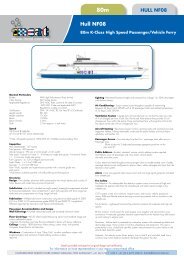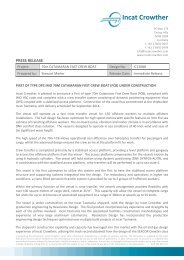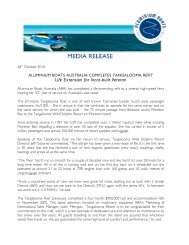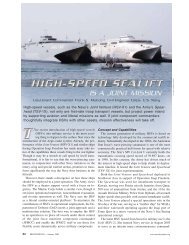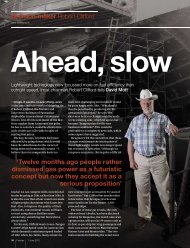US NAVY'S - Incat
US NAVY'S - Incat
US NAVY'S - Incat
Create successful ePaper yourself
Turn your PDF publications into a flip-book with our unique Google optimized e-Paper software.
from Belfast to Stranraer now takes 119<br />
minutes, an increase of up to 14 minutes<br />
on previous schedules depending on the<br />
time of day.<br />
However, both HSS’s are driven by powerful<br />
gas turbines with a fuel bill far in excess of<br />
<strong>Incat</strong>’s largest diesel craft – the 112 metre<br />
Wave Piercing Catamaran.<br />
The reduction in HSS speed has seen<br />
consumption drop from approximately<br />
30,000 litres per crossing to around 22,000<br />
litres per crossing from Holyhead - a saving<br />
of 8,000 litres per crossing. However, if<br />
we look at the <strong>Incat</strong> 112 metre running<br />
at 100% power, which nobody does, we<br />
see that she will burn around 13,000 litres<br />
for the berth-to-berth crossing – that’s an<br />
impressive 9,000 litres less than the speed restricted HSS.<br />
Reduce the engine RPM on the 112 metre vessel to<br />
a more normal 80% MCR and the consumption for a<br />
berth-to-berth crossing at around 34 – 35 knots drops<br />
to approximately 10,500 litres, or around 8.75 litres.<br />
We do not mean to say the HSS concept is flawed,<br />
far from it! However these vessels were designed<br />
in the 1990’s when oil was a fraction of current<br />
prices and were built to operate until at least 2022.<br />
They use more than twice as much fuel as a<br />
conventional ferry, consuming a Marine Gas Oil<br />
similar to kerosene used in jet aircraft and double the<br />
price of standard marine fuel.<br />
But some still claim that diesel high speed ferries<br />
are too costly to run in today’s economic climate.<br />
We think a look at the diesel high speed craft in<br />
historical context is warranted.<br />
This graph shows comparisons in fuel consumption per nautical mile between typical vessels.<br />
All vessels have what is known as hump spped.<br />
Large ships must operate best above hump speed. By operating <strong>Incat</strong>’s 112m vessels<br />
above hump speed, operators will benefit from the most efficient fuel consumption figures.<br />
T o n n e s p e r n a u t i c a l m i l e<br />
RO RO LIMIT<br />
no go zone<br />
BEST SPEED<br />
FAST SHIPS<br />
5 10 15 20 25 30 35 40 45 50<br />
Speed (knots)<br />
<strong>Incat</strong> THE Magazine Issue 36 29



